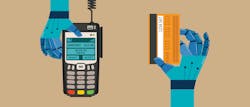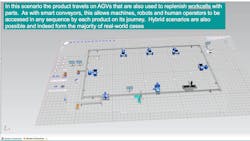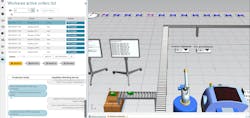Imagine the day when the packaging machine on the plant floor automatically detects that it needs more materials and it alerts the supplier—ordering and paying for product and scheduling delivery, all without relying upon any human intervention. Or a factory floor where machines self-organize and self-optimize themselves to heighten productivity, reduce waste, and increase product quality.
This is the day that the Industry 4.0 movement is working toward. In this future state of manufacturing, data and services are shared beyond the factory walls in a global inter-company communication infrastructure and payment network.
Some of it exists now. “Communication amongst machines to route around failures is already happening,” said Stephen Mellor, chief technology officer of the Industrial Internet Consortium (IIC) and executive vice president of the Object Management Group (OMG). “In fact, it’s what the internet was invented to do in respect to network nodes. In a factory, say, data would be gathered by nodes in the edge and they would make decisions on how to re-route around the failed machine.”
So while we’ve not completely entered the age of the machine economy, defined as a network of smart, connected, and self-sufficient machines that are economically independent and can autonomously execute transactions within a market with little to no human intervention, we are getting close.
The building blocks to create the factory of the future are here, including the Internet of Things (IoT), artificial intelligence (AI), and blockchain. This trifecta of technology has the potential to disrupt the industrial space, but it needs to be connected with a few more things, such as digital twin technology, mobile robots, a standardized way for machines to communicate, and smart services, like sharing machine capacity in a distributed ecosystem.
More importantly, there needs to be a framework to enable this ubiquitous interconnectivity. While technology companies build the machine-to-machine applications, there are industry efforts underway focused on building the underlying architecture and ecosystem of partners.
The IICF defines a reference architecture for opening up data otherwise locked in a plethora of domain-specific connectivity technologies used in IIoT systems, by using gateways to one of a few core connectivity standards that can provide syntactic interoperability without compromising the fidelity of the functional and non-functional aspects of the domain-specific technology.
The IIRA, a standards-based architectural template and methodology, enables Industrial Internet of Things (IIoT) system architects to design their own systems based on a common framework and concept. It addresses the need for a common architecture framework to develop interoperable IIoT systems for diverse applications across a broad spectrum of industrial verticals in the public and private sectors.
The BSIF provides a high-level identification and analysis of issues that any enterprise will need to address to capitalize on the opportunities emerging from this current revolution that is the IIoT.
And, addressing the cybersecurity challenge is critical to the success of the IIoT, Industry 4.0, and the Industrial Internet revolution. To that end, IIC members have developed IISF, a common security framework and an approach to assess cybersecurity in IIoT systems. It is the most in-depth cross-industry-focused security framework comprising expert vision, experience, and security best practices, according to IIC.
These are just a few of the IIC research and development projects that will move the industry forward.
“At seven years old, we have published several seminal documents that establish the machine economy landscape,” said Mellor. “We began several years ago with testbeds. As the name suggests, these were testing technologies and business models. We are now focused on deployments in industry that allow the target company to digitally transform their business.”
For example, a testbed in Cork, Ireland, called the International Future Industrial Internet Testbed (INFINITE), is developing software-defined infrastructures using big data that makes it possible for multiple virtual domains to securely run via one physical network. In phase one of the testbed, three geographically dispersed data centers are interconnected into a reconfigured Dell network. In phase two, INFINITE is applied to a use case called “Bluelight,” which allows ambulances to securely connect to a hospital’s system and relay information while in route, so hospital staff are prepared to take over the care of the patient once the ambulance arrives.
The ultimate outcome is to use smart data to improve the emergency services. According to the INFINITE testbed notes: “Consider the scenario where an emergency service vehicle is dispatched to an incident. The response time is critical. What if the real-time GPS data generated by the emergency service vehicle can be combined with other real-time data from diverse sources such as: current traffic levels for all routes to the incident, location of roadwork, diversions, and road closures. By combining and analyzing these diverse raw datasets in real-time in order to provide valuable and intelligent route planning and insights for the emergency service vehicle, response times will improve, leading to better life enhancing outcomes.”
This same concept could be applied to the plant floor. “Fleets of machines would gather data that is sent to a data center that can be compared and contrast and then change the operating parameters of non-optimal machines,” Mellor said.
To perform financial transactions, machines will need to have their “wallets,” which is something that the IOTA Foundation has been working on since 2017, when the non-profit initiative was founded. This international consortium of European universities and technologists came together to create a protocol layer for IoT that defines how devices transact with each other using trusted data across the technology stack in a virtual industry market place.
Today, while the premise is the same, the execution is different. “The vision of IOTA is the same for the machine economy. To provide a public protocol or better public infrastructure of automation and machines is still important. But we’ve refocused IOTA more to infrastructure,” said Holger Köther, director of partner management at IOTA Foundation, noting the organization has spent the last year and half rewriting the IOTA technology stack (node, libraries, wallet) from scratch while keeping the IOTA vision and current market requirements in mind.
In March, IOTA announced the beta launch of its Firefly wallet, giving cryptocurrency wallets a new benchmark in security and usability. At the core of Firefly are two new, open-source libraries, one for wallet application development and the other for security. It is also lightweight and uses the Edwards-curve Digital Signature Algorithm (EdDSA), which is natively supported by most IoT devices, Köther said.
In addition, a reengineered distributed ledger technology (DLT), called Tangle, enables secure micropayments between machines. It is open, feeless, and scalable, designed to support frictionless data transfer, and is not based on blockchain which has cost and scalability limitations, according to IOTA, which has a goal to build an entire ecosystem for machine communication that can apply to different industries.
“The overarching story is that IOTA is developer-friendly….and provides a DLT-based system that is resilient and scalable,” Köther said. In addition, the IOTA is working with the Open Management Group to certify the IOTA protocol and standardize how it works.
As the architecture and standards get sorted out, others are developing areas that will be an important part of the equation, like the digital twin. “To have the ability to send requests which can be fulfilled basically means having a digital twin of that product that has been designed, validated, and the part program processed for a particular machine. That is an important part of the equation,” said Alastair Orchard, vice president of Siemens Digital Enterprise.
To achieve the Industry 4.0 dream where cyber-physical machines can understand their own capabilities, negotiate with other machines, and can design any product, full digitized manufacturing is required And, of course, not every machine is intelligent.
“We are working on and deploying a transitional technology where we take the manufacturing blueprint called the bill of process, which is like a recipe that contains all of the information needed to manufacturing something, including the materials, the tolerances, the set points, and part programs,” Orchard said. “If [the machines] are not intelligent, we do have the possibility with our edge technology to create an intelligent wrapper around them, and then use the manufacturing blueprint to broker conversations between machine wrappers.”
A digital twin of the machine knows where all the product parts are to deploy a system where the bill of process is executed, distributed into edge boxes, and products are driven through the factory, communicating with brownfield machines through intelligent wrappers. “Key to this is logistics, either a smart conveyor or AGV to move product between machines. In this way we actually are able to kickstart fully autonomous and flexible manufacturing even though the machines themselves aren’t this super cyber-physical intelligent entity that we’ve been dreaming of.”
The ability to flexibly move things and capture that data across the supply chain is another area to tackle, according to IBM. “In today’s supply chain everything is siloed,” said Vijay Pandiarajan, director of operations at IBM Sterling, noting that there are so many steps in the process that it’s hard to reconcile everything—especially if a shipment didn’t arrive. “We have business transaction intelligence that maps out all of the documents you are supposed to get and sequence it.”
Business transaction intelligence, part of IBM’s Supply Chain Business Network, enables companies to garner deeper insights into supply chain data to help them better manage, for example, order-to-cash and purchase-to-pay interactions. The technology does this, in part, using machine learning to identify volume, velocity, and value-pattern anomalies in supply chain documents and transactions.
“It’s a simple example of AI,” Pandiarajan said. “AI won’t [solve] everything, but it will make you more capable as a human.”
Indeed, ultimately what the machine economy is trying to accomplish is to create a better human experience. Yet, people are the biggest bottleneck to the autonomous marketplace.
“The biggest obstacle is culture,” said IIC’s Mellor. “The average age of the industrial plant is 19 years. These are huge investments that last for decades. The organizations that run these facilities are very cautious. Even a 0.5% chance of failure can cost millions of dollars.”
But we do have the technology, and the critical steps to move toward the machine economy are happening now.
You can see it at Siemens, where a proof-of-concept M2M marketplace is underway with the goal of machines selling their own capacity. “There are so many areas of experimentation in our German machining factories, where each machine understands its own costs, its own schedule, its own maintenance, and communicates any windows of opportunity it has on a permission blockchain which others can subscribe to and request unused machine uptime capacity to machine their parts,” Orchard said.
It is an early example of how machines, using IoT, AI, and blockchain, may completely disrupt the manufacturing business model in the factory of the future.
About the Author
Stephanie Neil
Editor-in-Chief, OEM Magazine

Leaders relevant to this article:



